Research Journal
-
April 10, 2009
Paré’s Monsters
Tags:There’s a magnifabulous online book of the 1585 edition of Oeuvresby Ambroise Paré, 16th century surgeon, considered the first humane surgeon to come out of the barber-surgeon tradition. He was also very interested in ‘monstrous’ forms.
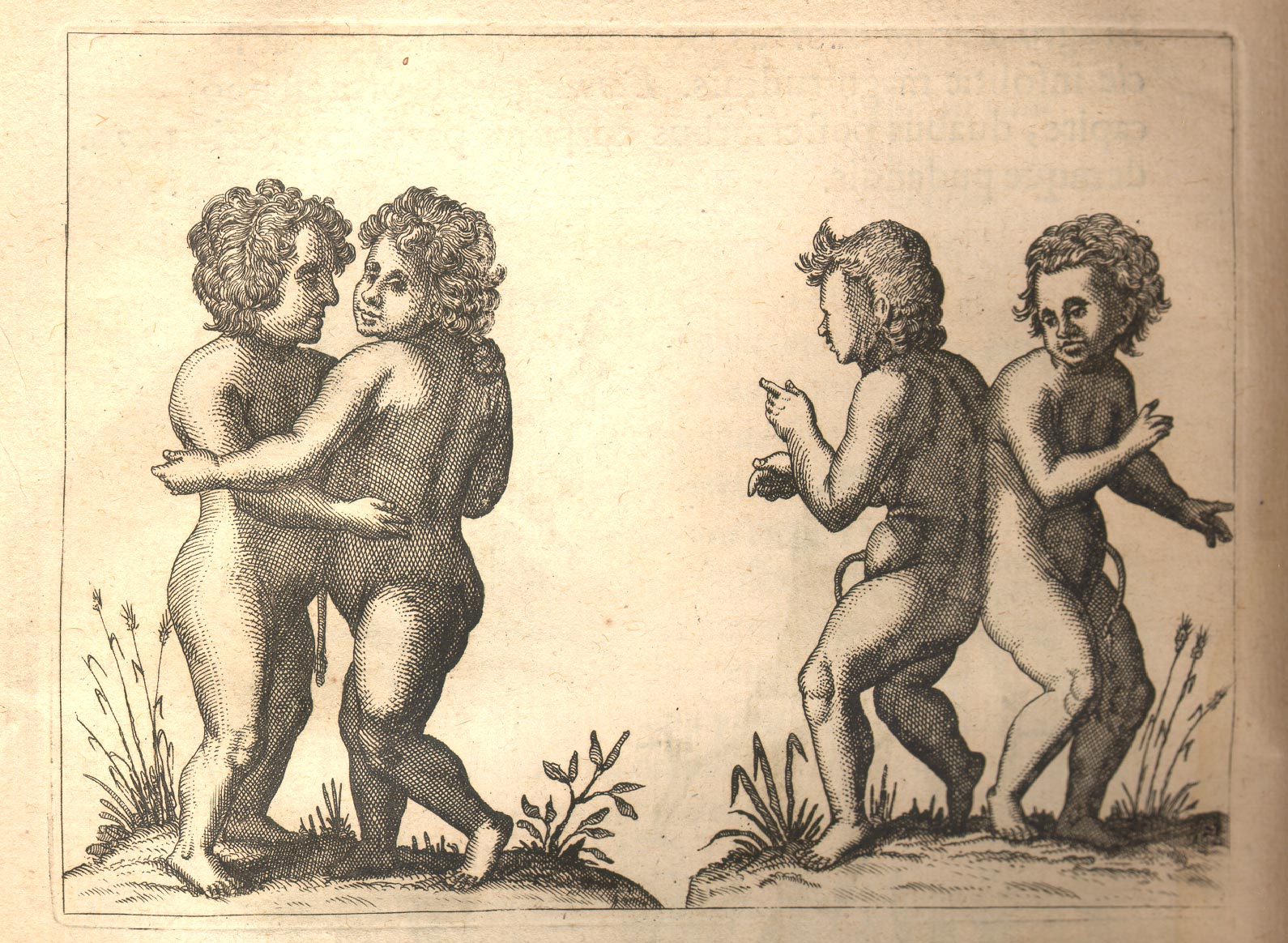
Siamese Twins, Ambroise Paré The book’s at the National Library of Medicine
-
April 10, 2009
Animal Estates
Tags:Fritz Haeg’s Animal Estates “produces events and exhibitions to consider the animals that we share our cities with, and creates dwellings for animals that have been unwelcome or displaced by humans. As animal habitats dwindle daily, Animal Estates proposes the reintroduction of animals back into our cities, strip malls, garages, office parks, freeways, front yards, parking lots, skyscrapers, and neighborhoods…
Dwelling designs for a variety of animals will be tested throughout the world. In cities and suburbs, from public streets to private yards, prototype Animal Estates will be established in a variety of environments. At times they will be hidden from view and at others quite visible to the public. Each will be designed to attract and welcome a particular animal back into an environment that has been dominated by humans. The design for each estate will be developed with a local specialist on that particular animal. These animals may at times be helpful and welcome residents, but others may require some getting used to.”

Utrecht, NL – Red Admiral Butterfly 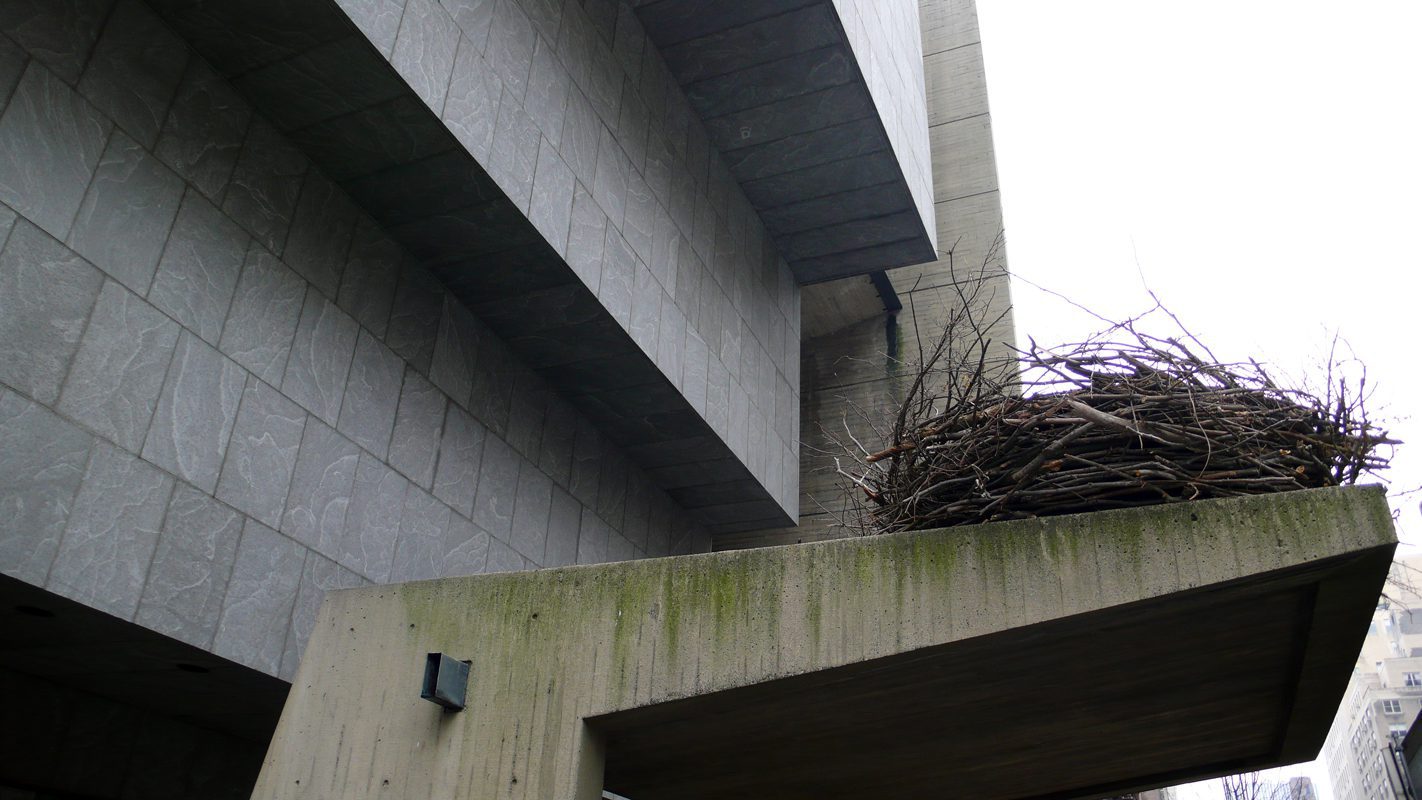
New York – bald eagle This is another great project from the same artist, Edible Estates, encouraging people to tear up their water guzzling grass lawns and replacing them with vegetable gardens. I got really excited when I saw the iteration in Lakewood, CA (a west coast Levittown) transformed into food.

Edible Estates in Lakewood, CA -
April 9, 2009
Interspecies Collaborations
Tags:I found this site originally from a class at UCSB, Interspecies Collaborations, “a collaborative research space for documenting the progress of art projects made together with non-human animals and for posting resources relevant to such endeavors.”
-
April 9, 2009
St Cuthbert, first animal rights advocate?
Here is an account of the life of St. Cuthbert as told by The Venerable Bede. Cuthbert is a 6th century proto St. Francis figure, famed in his time as a miracle worker. Cuthbert was born in Northumberland circa 634. .. at various times in his life, Cuthbert was a monk, a hermit, and – briefly – a bishop. He lived in the Lindisfarne Abbey, and died there in 687.
(“The Venerable Bede” was born in 673, in Northumberland, considered a prominent intellect and one of the most prolific writers in this early Christian era).The Farne Islands are an important locus for sea bird populations (including Pale-bellied Brent Goose, Wigeon, Teal, Pintail, Merlin, Dunlin, Bar-tailed Godwit). While resident there, St Cuthbert instituted special laws to protect the eider ducks and other seabirds nesting there, creating what may have been the first bird protection laws anywhere in the world. Consequently, eider ducks have long been known as ‘cuddy ducks’ (Cuthbert’s ducks) in the Pitmatic dialect as spoken in Northumberland.
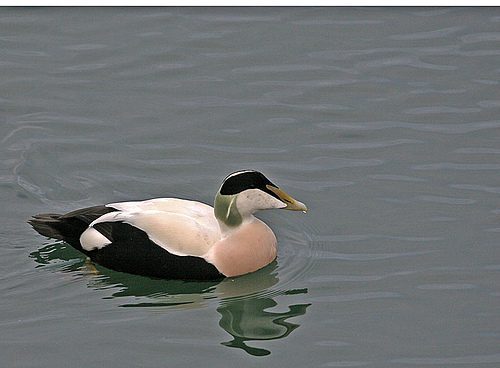
Eider or Cuddy Duck “Many times birds and animals obeyed him. Once, fasting on a Friday till the late afternoon, as he was wont, a horse found him half a loaf of bread in the thatch of a house. He gave half of the bread to the horse and took the rest for himself. Another time, after he had prayed all night long in the sea, two sea-otters came to warm his feet and dry him with their fur; they received his blessing. Again, after fasting, a large fish was brought to him by an eagle. The fish was cut in two, half for the eagle, half for a family and himself. ‘Learn to have constant faith and hope in the Lord. He who serves God shall never die of hunger’, said Cuthbert. Another time, when he ordered birds who had come to eat barley he had sown to depart, they obeyed him. Ravens were reproved by him and then later brought him lard as a sign of their repentance. ‘What care should men not take to learn obedience and humility’, he said, ‘when even birds hasten to wash away their faults’.”

Ernest-Ange Duez, Saint Cuthbert 1879 (Musée d'Orsay, Paris) -
April 9, 2009
St Cuthbert, first animal rights advocate?
Here is an account of the life of St. Cuthbert as told by The Venerable Bede. Cuthbert is a 6th century proto St. Francis figure, famed in his time as a miracle worker. Cuthbert was born in Northumberland circa 634. .. at various times in his life, Cuthbert was a monk, a hermit, and – briefly – a bishop. He lived in the Lindisfarne Abbey, and died there in 687.
(“The Venerable Bede” was born in 673, in Northumberland, considered a prominent intellect and one of the most prolific writers in this early Christian era).The Farne Islands are an important locus for sea bird populations (including Pale-bellied Brent Goose, Wigeon, Teal, Pintail, Merlin, Dunlin, Bar-tailed Godwit). While resident there, St Cuthbert instituted special laws to protect the eider ducks and other seabirds nesting there, creating what may have been the first bird protection laws anywhere in the world. Consequently, eider ducks have long been known as ‘cuddy ducks’ (Cuthbert’s ducks) in the Pitmatic dialect as spoken in Northumberland.

Eider or Cuddy Duck “Many times birds and animals obeyed him. Once, fasting on a Friday till the late afternoon, as he was wont, a horse found him half a loaf of bread in the thatch of a house. He gave half of the bread to the horse and took the rest for himself. Another time, after he had prayed all night long in the sea, two sea-otters came to warm his feet and dry him with their fur; they received his blessing. Again, after fasting, a large fish was brought to him by an eagle. The fish was cut in two, half for the eagle, half for a family and himself. ‘Learn to have constant faith and hope in the Lord. He who serves God shall never die of hunger’, said Cuthbert. Another time, when he ordered birds who had come to eat barley he had sown to depart, they obeyed him. Ravens were reproved by him and then later brought him lard as a sign of their repentance. ‘What care should men not take to learn obedience and humility’, he said, ‘when even birds hasten to wash away their faults’.”
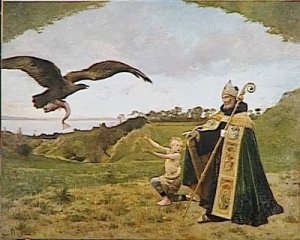
Ernest-Ange Duez, Saint Cuthbert 1879 (Musée d’Orsay, Paris) -
April 9, 2009
Other Nations?
Tags:I snagged this from The Atlantic, Andrew Solomon’s Daily Dish,
It’s a quote from Henry Beston’s The Outermost House:“We need another and a wiser and perhaps a more mystical concept of animals. Remote from universal nature, and living by complicated artifice, man in civilization surveys the creature through the glass of his knowledge and sees thereby a feather magnified and the whole image in distortion. We patronize them for their incompleteness, for their tragic fate of having taken form so far below ourselves. And therein we err, and greatly err. For the animal shall not be measured by man. In a world older and more complete than ours they move finished and complete, gifted with extensions of the senses we have lost or never attained, living by voices we shall never hear. They are not brethren, they are not underlings; they are other nations, caught with ourselves in the net of life and time, fellow prisoners of the splendour and travail of the earth.”
There’s been much writing lately around removing the hierarchical imposition of humans and the rest of ’em. I’m 100% plus on this one. But referring to non-human animal species as “animal nations” is problematic. Not sure how I feel about creating statehood for any of us. There’s far too much overlap, hybridity, intertwingling for such discrete apportioning. And the more we think about our (constantly) renaturing world, the more stories like the ones below emerge, and can’t be considered “naturally” aberrant, or completely the product of human artifice:
My friend Abigail Simon found this one.
and this one is very strange… I love it when you “sigh,” birdie.
Granted these are animals in altered (mediated by humans, forced cohabitation) settings, I’m trying to do research on wild instances of interspecies cooperation/curiosity. There are plenty of examples of tolerance (watering holes, feeding grounds, lakes, rivers). But the line between coexistence and cooperation is interesting.
-
April 8, 2009
Alexis Rockman at Nyehaus
Tags:Alexis Rockman has a show of new paintings at Nyehaus Gallery in New York.

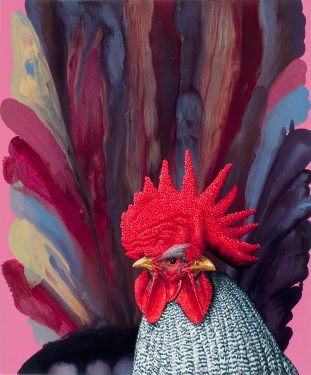
Bruce Sterling wrote that:
“Though he is known for the searing clarity of his paintings, there are things below the waterline that he does not paint.Years ago, the alligator made up his mind about these central issues in his oeuvre. He decided, as an act of deliberate will, to maintain his amphibious ambiguity. An ambiguity about the boundary of man and animal. An ambiguity about the borders of nature and artifice. Of art, of science…Human debris, sinking to the inky bottom of the alligator pond, a harvest too bitter even for the worms…Glassware, toxic vinyl, and shiny aluminum; a styrofoam soup in the Pacific, polar ice gone missing with no forwarding address, a food web blown to rotten lace, with gothic cobwebby holes of the vanished in the Sixth Great Extinction…A fantastic mulch of the natural and political. Yesterday’s brilliant inventions, more mortal even than their masters, become an ooze in the planet’s hidden waters, a toxic dust, the plaything of the whipping winds.Dripping mayhem covers the canvas: north, east, south and west, center, pole and periphery, forward and back in time. On any scale a monster might care to depict: glaciers, tornadoes, down the busily swarming bacteria, swapping their pirate cassettes of antibiotic resistance, like the music-tape pirates down at Saint Mark’s Place. New genes, plucked like snarled wire from the guts of a shattered piano, then kinked, knotted, plier-jammed into the tasty flesh of pigs, chickens and cows. Over-eager weeds break from concrete sidewalks bridging sullen, forgotten, still-dripping New York streams. “These paintings need to be seen in person; their alternately pasty palette-smeared impasto and resin-wet gloss surfaces mess with your eyeballs, vascillating between vivid, convincing representation and distressed, formal, melting swaths of color.
-
April 8, 2009
The Humboldt Squid
The Humboldt squid has 36,000 teeth in total. Moves fast. Eats dirty. Is big. Gorgeous, graceful, and alien creature.
“The Humboldt squid is a voracious predator that will eat anything it can get its tentacles on.” – livescience.com
Creatures of a new mythology. Moving up and down the water columns. Ecosystem parasites. Opportunists. Formidable monsters. Predators. I say monsters, because with climate change the Humboldt squid “substantially expanded its perennial geographic range in the eastern North Pacific by invading the waters off central California. This sustained range expansion coincides with changes in climate-linked oceanographic conditions and a reduction in competing top predators. It is also coincident with a decline in the abundance of Pacific hake, the most important commercial groundfish species off western North America.” – National Academy of Sciences
The squid are expanding their range vertically, in terms of depth and horizontally in terms of range, and eating away their prey. They are competing for our food, having outlasted their competing predators and exhibiting robust resistance to changing conditions.
Monsters represent a threat to our safety and livelihoods. They are our wily and flexible competitors.
-
April 7, 2009
Capt. Charles Moore on the seas of plastic | Video on TED.com
Charles Moore is founder of the Algalita Marine Research Foundation, one of the first to trawl the Garbage Patch. He captains the foundation’s research vessel, the Alguita, documenting the largest “landfills” of plastic waste that litter the oceans.
“A yachting competition across the Pacific led veteran seafarer Charles Moore to discover what some have since deemed the world’s largest “landfill” — actually a huge water-bound swath of floating plastic garbage the size of two Texases. Trapped in an enormous slow whirlpool called the Pacific Gyre, a mostly stagnant, plankton-rich seascape spun of massive competing air currents, this Great Pacific Garbage Patch in some places outweighs even the surface waters’ biomass six-to-one.”
-
April 7, 2009
Souvenirs from the Great Pacific Garbage Patch
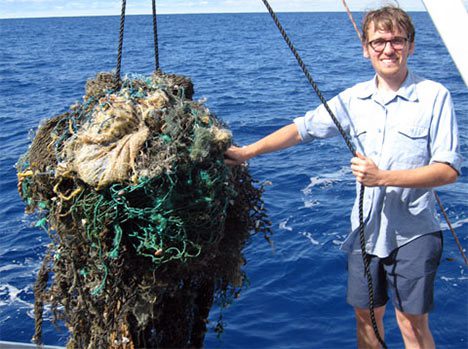
Photo from VICE TV's piece, Garbage Island. When I was digging around for Paradoxical Sleep, I wanted to find out what happened after San Jose’s Guadalupe River, after the South Bay of Northern California. The whirling gyre of nasty pollution information literally culminated in this vortex: The North Pacific Garbage Patch, an area the size of Texas that’s a confluence of ocean currents, north of Hawaii. Maybe it’s twice the size of Texas: it’s an undulating swirling mass; it’s a soup of industrial and consumer plastics; some are plastic pellets from manufacturing, small enough to be mistaken for plankton and eaten by marine animals; lots are large enough to comprise a bounty in a net haul.

